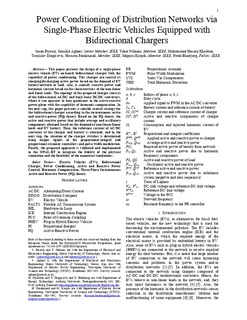Power Conditioning of Distribution Networks via Single-Phase Electric Vehicles Equipped
Pirouzi, Sasan; Aghaei, Jamshid; Niknam, Taher; Khooban, Mohammad Hassan; Dragicevic, Tomislav; Farahmand, Hossein; Korpås, Magnus; Blaabjerg, Frede
Journal article, Peer reviewed
Accepted version

Åpne
Permanent lenke
http://hdl.handle.net/11250/2639963Utgivelsesdato
2019Metadata
Vis full innførselSamlinger
- Institutt for elkraftteknikk [2412]
- Publikasjoner fra CRIStin - NTNU [37215]
Sammendrag
This paper presents the design of a single-phase electric vehicle (EV) on-board bidirectional charger with the capability of power conditioning. This charger can control its charging/discharging active power based on the demand of EV battery/network or load. Also, it controls reactive power and harmonic current based on the characteristics of the nonlinear and linear loads. The topology of the proposed charger consists of the bidirectional ac/dc and buck-boost dc/dc converters, where it can operate in four quadrants in the active-reactive power plane with the capability of harmonic compensation. In the next step, this paper presents a suitable control strategy for the bidirectional charger according to the instantaneous active and reactive power (PQ) theory. Based on the PQ theory, the active and reactive power that includes average and oscillatory components obtained, based on the demand of nonlinear/linear loads and EV battery. Then, the reference current of ac/dc converter of the charger and battery is obtained, and in the next step, the situation of the charger switches is determined using output signals of the proportional-integral and proportional-resonant controllers and pulsewidth modulation. Finally, the proposed approach is validated and implemented in the OPAL-RT to integrate the fidelity of the physical simulation and the flexibility of the numerical simulations.